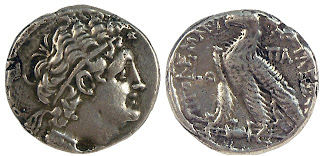Sadigh Gallery houses an extensive collection of ancient Greek coins at
our gallery, ranging from bronze to silver.
The most popular coins we have are Alexander the Great and Athenian
coins. To learn about these type of
coins we have, please read the following information. We hope these facts will ignite more interest
in ancient coins.
Alexander the Great Coin
Alexander, the great conqueror,
believed he was a direct descendant of Hercules. Before each battle and after each victory,
ritual sacrifices were performed honoring both Hercules and Zeus and he
selected their images to appear on these coins.
The front carries a likeness of Hercules adorned with the head of the
Thespian Lion, the killing of which was one of his great feats. His facial features were modeled after those
of Alexander the Great himself. On the
reverse, mighty Zeus rules from a throne.
He holds a scepter in one hand while an eagle rests upon the other. The
right field carries an inscription meaning (Money of) Alexander while the left
field contains the marks or symbols of the mint’s Magistrates. If Alexander’s legs were crossed, it would
indicate that the coin was struck posthumously (after the death of
Alexander). If, on the other hand, his
legs were placed together, it would indicate that the coin was struck during
the lifetime of Alexander.
Athenian Coin
Coins issued by certain cities or
empires took the leading role in dictating which coins were readily acceptable
for trade in the Mediterranean lands.
One such city was Athens, which established the ‘Attic standard’ that
was to be adopted later by Alexander the Great.
Silver was used to pay civil servants, soldiers and mercenaries, and it
is believed that the latter is the reason that many Greek silver coins were
struck in the first place. The non-Greek
lands of the Near East issued large quantities of silver coins, most notably
the Parthians, Sassanians and Baktrians.
These coins vary in style and fabric, the thickness and purity of the
planchet on which the coin was struck, and are relatively under valued compared
to the more widely collected issues of Greece proper. In Greek mythology, Athena was the Goddess of
warfare and wisdom. Later known as
Minerva by the Romans, she was, the Goddess of not only wisdom and battle, but
of certain crafts and the protector of all cities & states. At birth, according to one myth, she sprang
from the forehead of Zeus, the king of the Gods, fully grown and dressed in
armor. Athena is usually shown wearing a
helmet and a magic shield called the aegis.
The Goddess Athena was not only wise in war but also in the arts of
peace. She supposedly invented the plow
and taught men how to yoke oxen. Athena’s chief symbol was the owl and in Greek
mythology, the owl is firmly linked with Athena who is usually pictured with
her owl perched on her shoulder. Some
say that is why the owl is, in modern times, associated with wisdom.
Athenian coins were used in exchange
throughout the Greek world - hoards have been found as far away from Athens as
Babylon, Afghanistan and Iran. The
quantity of Athenian coins minted in last half of the fifth century BC, reflect
the changed and powerful position of Athens in the eastern Mediterranean. From a small city-state defending itself on
land against the onslaught of Darius at Marathon, Athens grew to be the center
of an empire whose power was dependent on its control of the sea. From being a
partner in and administrative head of the Delian League, Athens became its
leader and its many city-state members paid Athens tribute.
Common to all issues of the coin are
the Goddess Athena, in profile on the obverse, and the owl, her constant
companion, standing on the reverse, a sprig of olive leaves with a berry above
its shoulder. Variations in design exist
among denominations of the coin.
You will find various Greek coins on
sale located here:
For other coins, visit:

No comments:
Post a Comment